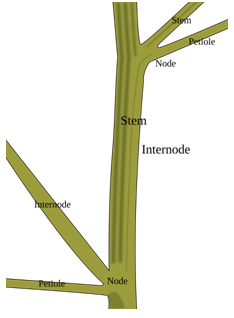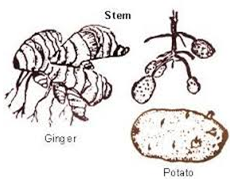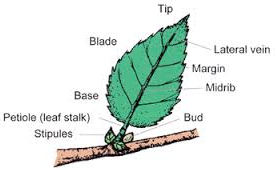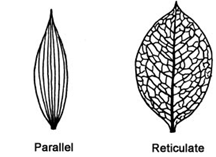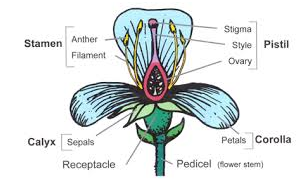Stem and Leaf
Getting To Know Plants of Class 6
Stem
The part of a plant which rises vertically up from the ground is called its stem. The stem of a tree is the strongest part of the tree and it is known as trunk. Most of the tree trunks are covered with a tough layer called ‘bark’. Bark protects the inner parts of a tree. The main functions of the stem of a plant are as follows:
(i) The stem holds the plants upright.
(ii) The stem of a plant carries water and minerals from the roots to the leaves and other parts of the plants.
(iii) The stem carries the prepared food from the leaves to other parts of the plant.
(iv) The stem holds the leaves in such a way that the leaves are able to get plenty of sunlight for preparing food by photosynthesis.
Modification of stem:
Food storage eg. Underground stem of potato, ginger stem. For support and climbing as tendrils like cucumber and grapevine. Thorns for protection like citrus.
Illustration 5: Name the two modified stem which help to store food.
Solutions: Potato, Ginger
Leaf
Leaves are an outgrowth of the stem and are green, thin and flat. These are attached to the stem by soft and thin petioles. The points of attachment in a stem are known as nodes. The flat, green structure of a leaf expanded horizontally is the leaf lamina or leaf blade. It is green in colour due to the presence of a pigment called chlorophyll, which carries out the process of photosynthesis. Each leaf has a central midrib which continues into a network of veins. The veins provide support to the blade and helps in the transport of materials to and away from the leaves.
Type of Venation
1. Reticulate: Net- like veins on both sides of the midrib. For example, peepal leaves, neem leaves etc.
2. Parallel: Veins, instead of forming web like network, are arranged parallel to each other. For example, banana leaves.
Function of leaf
1. Leaves manufacture food with the help of a green pigment called chlorophyll in the presence of sunlight, water and carbon dioxide. This process is known as photosynthesis.
2. The surface of the leaves have tiny pores called stomata. These help in the exchange of gases during respiration.
Modifications of the Leaf
In many plants, leaves perform functions other than the manufacture of food. These leaves are called modified leaves. Their functions are as follows:
(a) Additional support: like stem, leaves or leaf tips also modify into soft, coiled or wire-like structures called tendrils. They give support to the plants with weak stems. A few examples are pea and glory lily.
(b) Conservation of Water: You have studied that in desert plants like cacti, leaves are reduced to fine, pointed and hard spines. This modification of leaves helps the plant to conserve water and grow in desert areas.
(c) Protection: The leaves are modified into pointed spines to protect the plants from enemies.
Flower:
Flowers are the most colourful and attractive part of a plant. Different plants bear different types of flowers. These are the reproductive organs of the plants. Flowers appear on the plants only when the plants are fully grown.
A flower is attached to the branch of a plant by a stalk called pedicel. This pedicel swells up at its tip to
form a thalamus which in turn bears the parts of the flowers in four circles called whorls. Each whorl
consists of sepals, petals, stamens and carpels.
Sepals: The outermost whorl of a flower, green in colour is formed by sepals. These protect the young flowers or the buds. The whorl formed by sepals is called calyx.
Petals: These are bright coloured and have a typical odour to attract butterflies, bees, other insects and birds. All petals together form a second whorl called corolla.
Stamens: Stamens are the male reproductive organs of a flower. Each stamen is made up of a filament which bears a swollen structure at top called anther. Another consists of fine structures called pollen grains which bears the male gametes. The third whorl formed by stamens is known as androecium.
Carpels: The last whorl of a flower is called gynoecium and forms the female reproductive organ of a flower called carpel. The carpel is made up of a swollen base known as ovary which bears ovules. Each ovule contains a female gamete i.e. egg. The ovary is extended into a stalk-like structure called style, ending in a small round structure called stigma. The stigma receives pollen grains on its sticky surface which further results in fertilization.
Illustration 6: What is petiole?
Solutions: The stalk through which leaf is attached to stem.
